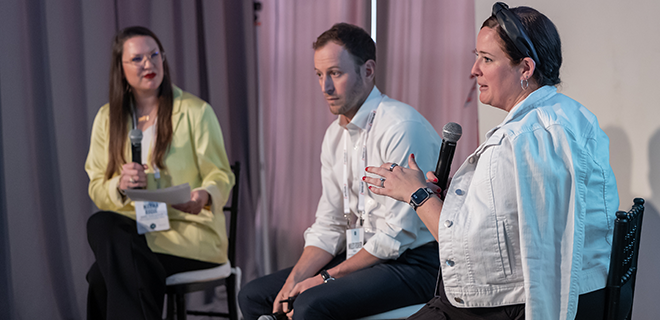
Consumer buying behaviors are constantly evolving.
We used to buy almost everything in person until online shopping became more popular. During the pandemic, many shifted to purchasing most of their items online, including essentials like groceries.
This comfort with shopping for goods online has opened up a new world of ecommerce, including shopping from the comfort of your living room couch.
In a session at Ops NYC, “Shoppable TV: Shaping E-commerce’s Future with Unique Consumer Experiences,” moderated by Marika Roque, Chief Innovation Officer & Chief Operating Officer for KERV and featuring Miles Fisher, Senior Director Ad Platforms & Growth Sales for Roku, and Amie Owen, US Head of Commerce for Universal McCann Worldwide, Inc. gave attendees a glimpse into the future of ecommerce.
How Users Interact with Shoppable TV
COVID significantly changed the retail and ecommerce spaces, says Owen, “I am super excited to be in the space because the convergence of retail and data allows us to really have that shoppable moment for everybody no matter where they are in their journey.”
Focusing on the holistic TV experience, Roku is extending that to what it means to shop via TV, notes Fisher. For example on TV, a call to action used to feature a flashing phone number on a television screen during an ad, but now a call to action might direct the consumer to visit a website or complete an action using their mobile device.
Since Roku is a subscription service, the streamer has built a direct relationship with 70 million consumers. This gives them access to email addresses, phone numbers, and credit card info, which provides more insight into who is watching when.
Ensuring positive user experiences with shoppable TV isn’t all that different from creating great experiences online. To achieve that, data plays a huge part in keeping users engaged, says Owen. Post-COVID shopping happens in more ways than before the pandemic, so understanding shopping behaviors can inform which ads to show consumers on their journey.
Best Practices and Strategies to Succeed With Shoppable
As more streaming services buy into the value of Shoppable TV, there will likely be hiccups along the way. Owen suggests three strategies to help make sure everything runs smoothly:
- Figure out your overall objectives, KPIs, and who you are trying to reach.
- Make sure your messaging is tailored to who you are reaching out to and what you are trying to accomplish.
- Continue to evolve and keep your pulse on the way the landscape is changing, because everything could be different as early as tomorrow.
And what works on mobile or desktop, doesn’t necessarily work for TV. “The production quality that people are used to on television is very different. And one of the things that we’re really focused on is making TV more accessible for other people to advertise,” notes Fisher. The cost per impression for TV is lower, but it’s worth taking some of that budget and putting it into production, he adds.
Roku is also working on making TV as shoppable as social. Consumers are already accustomed to picking up a remote while watching TV, and Fisher believes the remote will be a powerful tool going forward. Roku is also looking into ways to create interactive overlays that will encourage people to use their mobile devices to complete a purchase, with QR codes continuing to be a piece of the puzzle.
Approaching the Consumer at the Right Time and in the Right Way
Regardless of the way it happens, converting sales comes down to creating a call to action and offering the consumer something valuable in exchange for their information. All of this circles back to understanding audiences through the data they share.
When Roku partnered with DoorDash to offer customers a $5 off coupon if they ordered in real-time, it was a way to surprise and delight them, Fisher says. That’s just one way to deliver value.
Then there’s how retail data can help brands close the attribution loop. UM Worldwide partnered directly with Kroger to leverage their first-party data to reach users who purchase beauty products, which led to a threefold increase in return over the previous results, shares Owen.
Partnering with different companies and sharing data in a way that remains privacy safe – which is crucial – can help increase leads, Fisher agrees. The ROI results from these partnerships can sometimes even be seen in real-time. Other times, it may take six to eight weeks for data to be available.
The Future of Shoppable TV
In the next year, the shoppable TV sector could look completely different. So what about in five to 10 years?
In the next year to three years, Fisher predicts there will be an increase in the video quality of TV ads, possibly aided by AI technology. TV is built for mass marketers to succeed and they will likely continue to do so, he adds.
In the next five to 10 years, Owen predicts that consumers won’t only be shopping through TV, but through a variety of smart appliances. From the refrigerator that keeps an inventory of what you have stocked to the laundry machine that calculates how many loads of laundry you do in a typical month and prompts you to reorder detergent through Amazon, there will be a whole home ecosystem of places to shop.